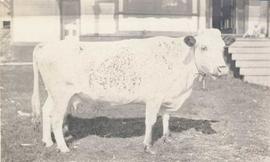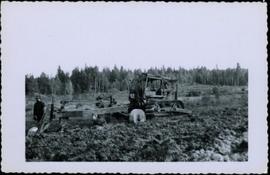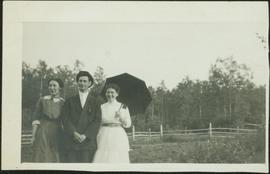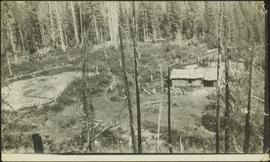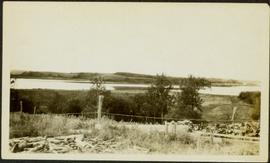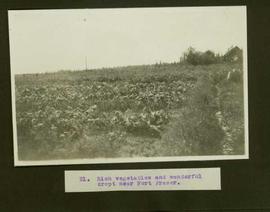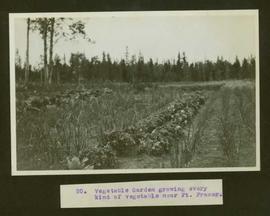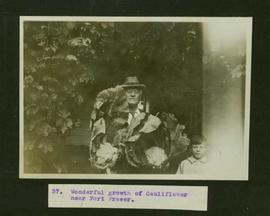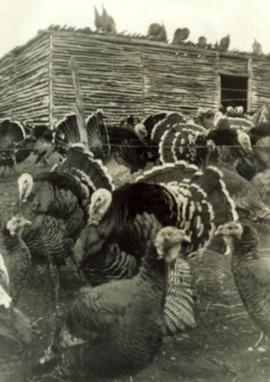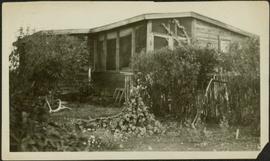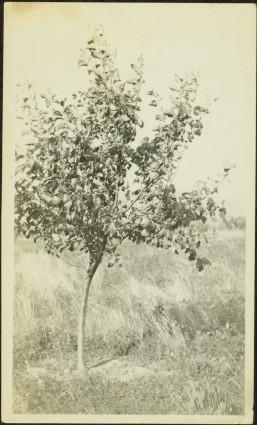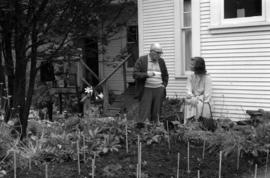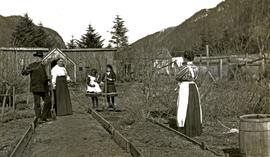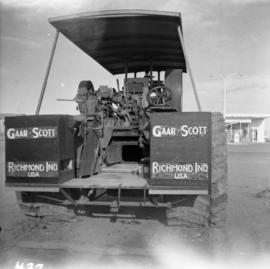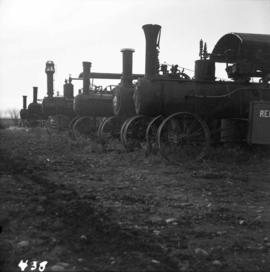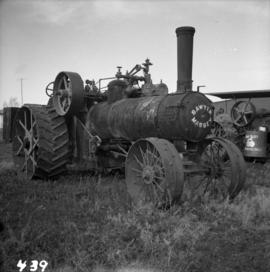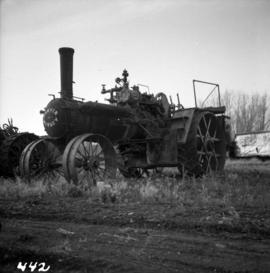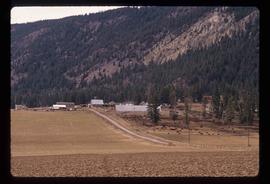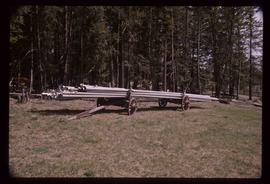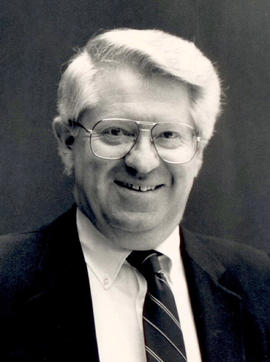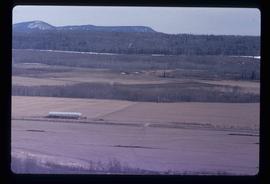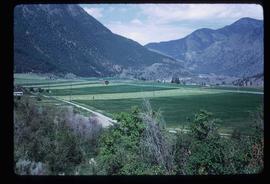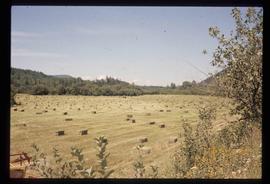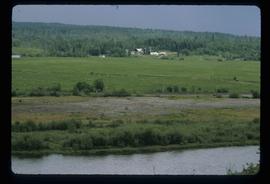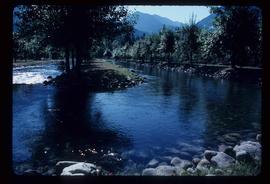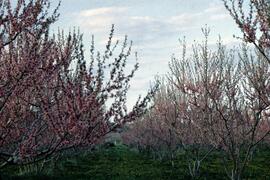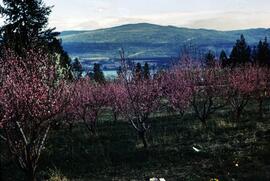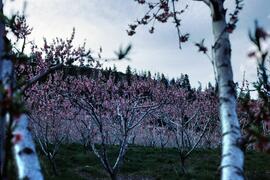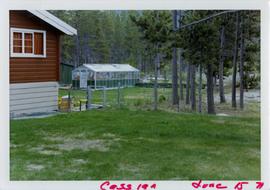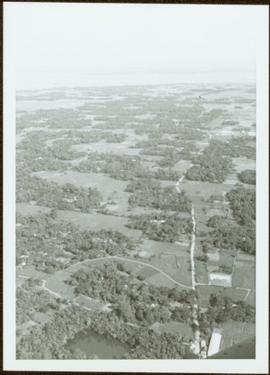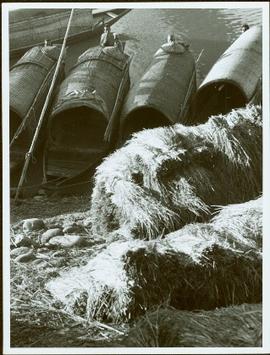Photograph depicts a cow with a bell around its neck standing in the front yard of a house.
Unidentified man standing next to farming equipment in a newly ploughed field on the Scholander Farm.
Photograph depicts H.F. Glassey standing between two women. Sarah stands on right, holding umbrella. Cleared area in front of fence crosses midground, forest in background.
Photograph depicts farmstead in cleared area of forest. Plowed and fenced area on left, buildings and firewood on right.
Photograph depicts a river or lake, and opposite shore in background. A garden can be seen behind fence in foreground.
Typed caption glued to album page directly below photograph reads: "47. Rich farm land at Fort Fraser." Photograph depicts farmland surrounded by wooden fencing. Photographer: Dominion Stock & Bond Corporation.
Typed caption glued to album page directly below photograph reads: "21. Rich vegetables and wonderful crop near Fort Fraser." Photograph depicts farmland; a house and a wooden fence visible in background. Photographer: Dominion Stock & Bond Corporation.
Typed caption glued to album page directly below photograph reads: "20. Vegetable Garden growing every kind of vegetable near Ft. Fraser." Photograph depicts rows within a vegetable garden. Photographer: Dominion Stock & Bond Corporation.
Typed caption glued to album page directly below photograph reads: "37. Wonderful growth of Cauliflower near Fort Fraser." Photograph depicts an elderly man holding two large cauliflower heads, a small boy stands next to him. Photographer: Dominion Stock & Bond Corporation.
Turkeys in foreground, shed in background.
Photograph depicts hedges and creeping foliage around picket fence in foreground. House stands in background featuring enclosed porch. Handwritten annotation on recto of photograph: "Merry Xmas + Happy New Year Aunt Lillian. This is my garden in the foreground the main thing in view being the morning glories. Lots of love Jean."
Photograph features one apple tree, field in background. Handwritten annotation on recto of photograph: "This shows size of trees." It is believed that this photograph was given to Lillian & A.K. Bourchier by their niece Jean.
Photograph depicts Iona Campagnolo sitting and talking with an unidentified man in a home garden, possibly in Prince Rupert.
Photograph depicts Marion and William Henry Collison standing on left with shovel, Bertha Collison on right, and young Muriel and Katherine Collison in centre with shovel (eldest daughters of W.E. Collison). Wood buildings cross midground, trees and hills visible in background.
Handwritten annotation on verso reads: "Garden at Kincolith / Grandad, Grannie / Mimi, Katie / Mother".
Photograph depicts the rear view of the Gaar Scott traction engine parked at Texcoc Station in Nanton, Alberta. The rear wheels have a 2'9" tread. It was used on farms for haulage, threshing, chaff cutting etc., but not plowing.
Photograph depicts traction engines owned by Jack Burrows in Nanton, Alberta. There are six in this photo, all of which appear could be steamed, another two in derelict condition, and one in the village in working order. Running from front to rear in the photo: 1) Reeves with roof, U.S. 2) Waterloo, Ontario, Canada 3) Massey, Canada 4) Gaar Scott with roof, U.S. 5) Massey, Hamilton, Canada 6) Gaar Scott, U.S.
Photograph depicts a Sawyer Massey steam engine in Nanton, Alberta. It was built in Hamilton, Ontario. It has a single cylinder and large fire box for burning wood or straw.
Photograph depicts a Sawyer Massey traction engine in Nanton, Alberta. The device parallel and topside of the boiler to heat feed water. The water tank is small so it must have had a water cart in constant attendance.
Image depicts a farm at an unknown location.
Image depicts a pile of irrigation pipes on a dairy farm somewhere near Quesnel, B.C.
File consists of a transcript of an oral history interview with Marilyn Wheeler.
This fonds illustrates the life and work of G. Gary Runka and his contributions to the province of British Columbia. Gary Runka was the first General Manager of British Columbia's Agricultural Land Commission and helped establish the provincial Agricultural Land Reserve. After transitioning from a government career to private consulting, Runka provided comprehensive professional services through his land consultancy business, G.G. Runka Land Sense Ltd., offering land capability and environmental assessments, integrated resource management, land and water use conflict resolution, and interdisciplinary land use planning. Described by colleagues as one of BC's most highly respected agrologists and influential land use planners, Runka had a 52-year career working on (or against) an incredible number of landmark projects in British Columbia, such as the Site C Project. Gary Runka’s partner in life and vocation, Joan M. Sawicki, worked with Gary on many of these projects—as well as her own; her contributions are also represented throughout the records of this fonds.
Gary Runka's deep connection to the land is evident from his earliest papers on aerial photo interpretation, his work with the Canada Land Inventory, through his speeches and his work establishing the BC Agricultural Land Reserve and in his subsequent consulting career through G.G. Runka Land Sense Ltd. Gary Runka's influence and legacy was recognized in the tributes paid after his death, including the post-humus award as the Real Estate Foundation's "Land Champion" for 2014.
The G. Gary Runka fonds has been divided into the following nine series:
1) Personal Records
2) Speeches & Publications
3) Professional Records
4) Agricultural Land Commission
5) Land Sense Ltd.
6) Client Files
7) Maps
8) Photographs
9) Digital Records
File consists of a speech given by Gary Runka to the Kelowna Chamber of Commerce Environment Committee entitled "The Canada Land Inventory, Land Capability Analysis and the Chamber of Commerce".
Commentary on this speech by Barry Smith of the Ministry of Agriculture and Lands:
"GGR makes the point in opening that the Chamber of Commerce may not be a group the public normally associates with concern for the environment but he feels it is time to correct this fallacy.
This speech is of value, if for nothing else, for the outline provided of the origin of the Canada Land Inventory (page 2).
Interestingly in the light of a future Land Commission publication, GGR uses the phrase "...with proper inventory information perhaps we would have left some of our options open". The 15 page B.C. Land Commission booklet published in March 1975 [was titled 'The B.C. Land Commission: Keeping the Options Open']."
File consists of a speech given by Gary Runka entitled "Physical Resource Data Needs in Land Use Planning" which was given at a technical workshop to develop an integrated approach to base data inventories for Canada's Northland.
Commentary on this speech by Barry Smith of the Ministry of Agriculture and Lands:
"While the speech is not related to agriculture or farmland preservation directly, GGR emphasises the importance of data collection and mapping and its use in the planning process. The general principles he discusses were those employed in the development of the Agricultural Land Reserve.
The proceedings of the workshop were published in 1979 by Environment Canada." The proceedings are available online at: https://www.geostrategis.com/PDF/1974-04-17%20remote%20sensing%20for%20northen%20surveys%20and%20environmental%20monitoring-jean%20Thie%20CCRS%20copy.pdf
File consists of a speech given by Gary Runka to the BC Federation of Labour Environmental Conference entitled "Planned Development and Land Conservation".
Commentary on this speech by Barry Smith of the Ministry of Agriculture and Lands:
"GGR discusses the 'problem' of land being considered as either an "ecological natural resource" or "hot commodity".
He mentions that his background is in the natural sciences and land use planning and prefers to look at land as an ecological resource, not simply as a commodity.
The speech includes a quick review of the Land Commission's work and with reference to the Land Commission Act he makes the following observation (p.2):
"...the purpose is hardly necessary to relate to you - as what animal survives that destroys his food habitat next to his shelter or cover?"
The reason for BC's farmland preservation program could hardly be better stated."
File consists of a speech given by Gary Runka entitled "Resource Use Conflicts - The Fight Over What's Left" at the Canadian Bar Association Winter Meeting, Harrison Hot Springs.
Commentary on this speech by Barry Smith of the Ministry of Agriculture and Lands:
"The panel discussion that GGR was participating in was entitled "Resource Use Conflicts - The Fight over What's Left".
GGR makes the point that without legislative steps to preserve agricultural land in BC, what would be left in terms of farmland in not too many years would be "nothing at all". After this reinforcement of the need for the Land Commission Act he explains briefly the designation of the ALRs and comments at length on the different types of applications.
It is explained that the ALR is based upon agricultural capabilities of the land:
"In other words, a soil/climate combination. The ALR is aimed at preserving agricultural land in the long term. Factors, such as parcel size, economic viability, current market conditions, ownership etc. play little or no role in the decision-making process."
In light of a considerable amount of the Commission's workload being focused on the processing of applications GGR remarks that:
"If we are sincere in our attempts to preserve an agricultural land base for future generations of British Columbians, we must regard the ALR as only a first step of many that are needed."
A flow chart is referred to but not included in the package."
File consists of a speech given by Gary Runka entitled "B.C. Agricultural Land Preservation Program". This speech was originally given on March 23, 1977 at the Sol Conservation Society of America National Symposium. Includes a version of the speech turned into a paper submitted for publication as "British Columbia's Agricultural Land Preservation Program" in the Assessors Journal. The speech and paper is accompanied by:
- supplementary transparencies for presentation
- Resume for G. Gary Runka
- Canada Land Inventory Ratings
- Summary of Applications Processed under the Land Commission Act
- Areas Included and Excluded from the ALR by Year
- Flow Chart for Applications under the Agricultural Land Commission Act
Commentary on this speech by Barry Smith of the Ministry of Agriculture and Lands:
"This speech was given on March 23, 1977 and represents a major paper given to an international audience.
GGR provides a contextual overview of B.C. and breaks his speech into an overview of the legislation, how the ALR was established and the administration of the Reserve.
The speech, in part, draws upon themes in other speeches but this paper tends to pull all these subjects together in this single presentation.
GGR notes that up to this point 80% of the exclusion applications are from non-farmers and it is estimated that the program has saved 40,000 acres (16,187 ha.) of farmland from being converted to irreversible uses.
GGR outlines several key principles to having a successful program to preserve agricultural land including:
- Regulations must be based on solid technical data people can understand;
- Any control mechanism needs to be basically apolitical;
- Must include shared decision-making - local governments and the public were involved in creating the ALR plans and local governments continue to provide comments and recommendations on applications; and
- Ensure opportunity for integration and communication with the Ministry of Agriculture and other provincial government agencies and Advisory Committees of the B.C. Federation of Agriculture.
This speech was published as part of the symposium proceedings: "Land Use, Tough Choices in Today's World: The Proceedings of a
National Symposium, March 21-24,1977, in Omaha, Nebraska" by the Soil Conservation Society of America."
File consists of a speech given by Gary Runka to the BC Provincial Seed Fair in Fort St. John entitled "Land Use Planning and the Farmer".
Commentary on this speech by Barry Smith of the Ministry of Agriculture and Lands:
"Given the title and the audience, this speech reads like a wake-up call to farmers to pay attention to land use planning issues and get involved. Despite the available copy of the speech appearing as a draft the nature of the topic - farmers needing to get involved in land use planning - establishes a point that GGR obviously feels is important in the overall effort to preserve agricultural land.
The speech includes several examples of land use planning that can affect the agricultural industry including:
- Rural zoning by local governments and the provincial ALR zoning;
- Hydro-electric planning (a reference in all probability to Site C);
- Preparation of regional, community and particularly settlement plans;
- Industrial land development strategies;
- Federal fisheries legislation;
- Transportation planning;
- Crown land lease proposals;
- Water resources;
- Various other land use initiatives involving wildlife habitat, open space recreation, historic and archeological sites; and
- Taxation and assessment policy
Stapled to the original typed speech is a set of hand written notes (not copied) that are largely identical to the typed version. The typed version does have a few mysterious blanks but when checking the handwritten version the blanks may simply represent illegibility problems with the hand writing at the time of typing. Given these blanks, this may in fact have been a first draft of the speech with a cleaner copy typed up prior to delivery."
File consists of an untitled speech about resource conflicts given by Gary Runka to the Society Promoting Environmental Conservation (SPEC) Annual General Meeting in Vancouver.
Commentary on this speech by Barry Smith of the Ministry of Agriculture and Lands:
"The original version consists of 3 pages of hand-written notes that were accompanied by slides (not available). The hand written notes have been transcribed.
GGR outlined several societal needs and wants but emphasises that we don't have enough land to provide for all these needs and desires if we keep planning in a haphazard manner.
He urges environmentalists to be prepared technically and avoid the image of being opposed to everything. He calls for greater integration in dealing with resource issues.
GGR was the keynote, guest speaker at the meeting."
File consists of the written personal reflections of Gary Runka for the "'Ten Years of Agricultural Land Preservation", December 1983.
Commentary on this speech by Barry Smith of the Ministry of Agriculture and Lands:
"These personal reflections were prepared by GGR for publication in the ALC's document commemorating its 10th anniversary entitled "Ten Years of Agricultural Land Preservation". These reflections form pages 33 - 35 of this 61 page document.
The reflections portray the hectic start of the Land Commission's work but also inform us of GGR's role prior to becoming the Commission's first General Manager. As noted, "I had been extensively involved in drawing up the "suggested ALR plans" for the various regional districts while working with the Soils Branch of the Ministry of Agriculture." He then accompanied the Commission on their initial meetings with regional districts and local governments around the province.
The fact that GGR played a key role in developing the CLI mapping (an important basis of the ALR), then was involved with drawing up the suggested ALR plans, followed by his efforts as ALC General Manager to implement the Reserve plans, and finally sign off on the completed ALR plan map sheets, arguably makes Gary Runka, like no other person, the "Father of the ALR"."
File consists of a speech given by Gary Runka entitled "Habitat, Land Use Planning, Economics and the Land Owner" to the 43rd Federal-Provincial Wildlife Conference in Regina.
File consists of a speech given by Gary Runka entitled "Winter Range for Ungulates" for the Symposium on Threatened Species and Habitats in British Columbia and the Yukon.
File consists of a speech given by Gary Runka entitled "The Rural-Urban Continuum: Tough Land Use Choices Ahead" for the Vernon Rotary Rural-Urban Day.
Commentary on this speech by Barry Smith of the Ministry of Agriculture and Lands:
"This speech / paper does cover some old ground dealt with in other speeches but is nicely brought together here.
GGR outlines several competing land uses and uses agriculture as a starting point in setting the stage by noting that there are just 74,400 food producers and 2,400,000 other British Columbians.
An emphasis is placed on communications, especially since most planners and politicians are overwhelmingly urban oriented. When involved with rural planning it is important to understand the rural side of the fence and look back at the urban area rather than the other way around. This means "understanding the natural characteristics of the land resource and its ecosystems."
Seven issues are considered:
- Short-sighted premises - the supply of land is limitless and the individual has the right to use his
land as he wishes without affecting others; - The interdependence of man within natural systems is not fully appreciated;
- Reluctance of rural people to accept planning programs;
- Institutions and organizations reflect rural reality;
- Sprawl is not confined to urban areas and when it affects the rural area it can be a large problem;
- The dilemma of wanting data to make good land use decisions, but while we wait for information,
bad decision are being made; and - What is politically palatable?
The speech ends with the need for rural and urban communities to be mutually supportive. While farmland preservation isn't central to this speech the rural resource and planning theme is relevant."
File consists of a panel moderation talk given by Gary Runka entitled "Methods of Resolving Land Use Conflicts in BC".
File consists of a speech given by Gary Runka entitled "BC Soil Conservation Issues: How Serious are They?" for a BCFA Soil Conservatiori Seminar - March 10,1987.
Commentary on this speech by Barry Smith of the Ministry of Agriculture and Lands:
"Stressing the importance of soil conservation, this speech begins by noting that all land and water users (not just agriculture) - on-site or off-site - are involved with soil conservation.
The paper is broken into 3 sections:
(1) Framework Considerations in which the diversity of BC's landform and climate is noted. The key soil conservation issues from a provincial perspective are reviewed including:
- erosion;
- sedimentation;
- acidification;
- organic matter loss; and
- soil compaction.
(2) Economic Considerations - the estimated loss annually in agriculture due to soil erosion is 30 to 50 million dollars.
(3) Legislation and Institutional Structure Considerations - BC is noted as having no provincial legislation that has soil conservation as its main thrust.
While the ALC Act and ALR are not directly mentioned, soil conservation is an important associated issue related to farmland preservation."
File consists of a speech given by Gary Runka entitled "Working Together Towards Identifying and Protecting Land for Nature in the Kamloops Area" to an unknown audience.
File consists of a speech given by Gary Runka entitled "Landscape Level Planning - Fitting People into the Watershed" at the Stewarding Our Watersheds Conference.
Commentary on this speech by Barry Smith of the Ministry of Agriculture and Lands:
"The first half of this speech takes a very broad sweep in defining landscape units and the provincial planning system. In the second section "Entering the People Use Maze", the paper focuses more locally on the Salmon River watershed and discusses the findings of a survey associated with the Langley Rural Plan.
The survey results demonstrated that for both rural and non-rural residents in Langley, 'the country atmosphere' was why they had chosen to live in Langley. Residents also disagreed with the statement that it was unpleasant to live in an agriculture area.
The third section - "Techniques of Integrating Balanced, Sustainable People Use" into the Watershed" considers eight tools that will assist achieving "landscape level" planning, one of which is the ALC Act.
Besides these direct references to agriculture, country atmosphere and ALC Act; the Langley Rural Plan drew heavily on the survey that GGR refers to and the Plan, which was largely comprised of agricultural lands, was inspirational in the development of the Commission of work "Planning for Agriculture".
File consists of a speech given by Gary Runka entitled "Managing Conservation Lands to keep Nature's Pulse Beating" for the BC Trust for Public Lands.
Commentary on this speech by Barry Smith of the Ministry of Agriculture and Lands:
"GGR's was the opening address at the workshop. While this speech is focused on the issue of Best Management Practices (BMP), comments about the ALR are woven into the presentation. This copy of the speech appears to be a draft version and includes several hand-written amendments with some points crossed out.
In the opening, mention is made of the grounding that the 2008 document "Taking Nature's Pulse: the Status of Biodiversity in British Columbia" has provided the workshop.
This speech provides an historical overview of the broader provincial context of BMP's drawn from 40 years of GGR's experience. The following is a selection of his comments:
- BMP's are part of the "tool kit" of policy and management mechanisms that have been experimented with over the decades to try to rationalize human economic activities with the needs of other species and overall ecosystem well-being.
- Historically the 1960s and 70s Canada Land Inventory program that emerged from the Resources for Tomorrow conferences was a significant benchmark mapping land capability for agriculture, forestry, recreation, wildlife and waterfowl use (of which GGR was centrally involved).
- Within BC, using the CLI, the 1973 Land Commission Act authorized the establishment of a provincial zone to protect those sacred lands with the biophysical capability to grow food.
One point was not used in the speech (crossed out). The speaking notes, however, include a reference to the Land Commission legislation originally having a complimentary conservation objective that had since been removed. GGR makes the point that still having the conservation function may have contributed positively to current struggles to preserve natural habitat. Regardless, it is noted that the concept of the ALR has been a unique, effective and, most importantly a lasting management practices tool for conserving lands identified as biophysically significant.
A further selection of points made:
- We need to evolve BMP tools that are adaptable yet resilient in the face of changing knowledge, climate change and ever-evolving social priorities.
- Traditionally, planning has been most associated with local governments in the form of official community, regional and neighbourhood plans and as an outgrowth of the ALR - Agricultural Area Plans.
- Environment Farm Planning - by agreeing to engage in the conservation planning process, participating farmers and ranchers have qualified for funding to carry out farm improvements benefitting conservation and biodiversity.
- The work of the Delta Farmland and Wildlife Trust is outlined (p. 8)
- "My final words of wisdom are - Be focused and be pragmatic"
- "Many of the best intentions to standardize land management practices for conservation lands have been great on paper - but never quite make it on the ground."
- And, if BMP are not implemented effectively on the ground, they cannot play the critical role they need to play in 'keeping nature's pulse beating'."
Image depicts a view of some farm land in Chetwynd, B.C.
Image depicts some farmland in Lillooet, B.C.
Image depicts a field of hay somewhere in Beaver Valley.
Image depicts a farm in Giscome, B.C.
Image depicts water flowing through an irrigation channel in an orchard, somewhere in or near Seton Portage, B.C.
Disc contains a single file, "GGR 2A.ppt", which is a PowerPoint presentation by Gary Runka entitled "The Agriculture Land Reserve: What it is and how it got here" created April 18, 2002.
Slide depicts peach trees blossoming in an orchard. Original slide index description: "Peach blossoms Shanboolard."
Slide depicts peach trees blossoming in an orchard. Original slide index description: "Peach blossoms Lakeview Heights."
Slide depicts peach trees blossoming in an orchard. Original slide index description: "Peach blossoms Casa Loma."
Photograph depicts part of a brown and white building similar to the "Director's Lodge" at Cassiar, B.C. (see items 2000.1.1.3.19.88 and 2000.1.1.3.19.89). Unidentified individuals visible inside greenhouse in fenced back yard. Forest in background. Handwritten annotation on verso of photograph: "Cassiar June 15 71".
Item is a photograph of forests and farms from the air.
Item is a photograph of boats docked on the shore behind piles of grain or straw.
